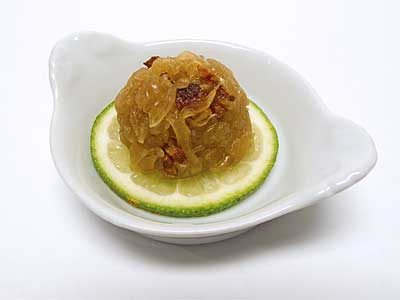February 6, 2012
Amuse-Bouche

choucroute d’oignons
(fermented onions)
I wonder what went through the heads of a mid-18th-century, Bavarian nobleman’s children when they recited their catechism and came to the parts about sauerkraut, or what went through the minds of British sailors later in the century when they were told that they would eat sauerkraut to help combat scurvy. Sauerkraut has become a seldom-served side dish in American cuisine, but in some past cultures, it was very important. Fermented cabbage, with its accompanying benefits, has been around for a long time.
In parts of 19th-century, yet to be unified, Germany, whole towns came together to prepare the year’s ration of sauerkraut. Barrels were filled with cabbage and salt, and the townspeople would walk on the mixture with their wooden shoes. They continued until the shredded leaves expelled enough water to isolate the cabbage from the air, thus allowing the anaerobic bacteria to properly ferment and preserve the cabbage for the winter.
I remember reading about these German sauerkraut “assembly lines” and feeling vindicated. In the 1970s, I attempted to make sauerkraut, but it quickly turned into a moldy mess. The “modern” recipe assumed that enough liquid would be produced by the cabbage, when it was in contact with the salt, to cover the assemblage before mold would set in. It was much later when I first applied the Japanese quick-pickle technique of massaging vegetables to quickly release the water from the cabbage leaves. Although I used my hands instead of my feet, the result was the same. Copious amounts of liquid was expelled by the cabbage, and it was easy from the outset to keep it submerged. Two weeks later I had my first batch of yummy sauerkraut.
Since then, I’ve learned from Ken Albala in his book, The Lost Art of Real Cooking, that almost any vegetable can be fermented with the addition of the right amount of salt. As I stated in last week’s blog post, last spring I found myself blessed with a bunch of uncured red onions. Like cabbage, onions are more than 90% water, so maybe, I thought, they could be fermented in a similar manner.
Using a Benriner set to its thinnest setting, I sliced all the onions into rings and placed the results on my digital scale. I divided the weight of the onions by 20 and added that much fine salt to them. After a quick massage with my finger tips, the onions secreted sufficient water to allow them be totally covered when they were pressed down into the newly formed brine. The onions and the water were placed into a one-liter Cambro, and a perforated metal disk was place on top to hold the onions below the liquid. Lastly, the lid, which doesn’t provide a gastight seal, was snapped onto the Cambro. (I wouldn’t want the container to trap the carbon-dioxide gas given off by the fermentation process.)
After two weeks on my kitchen counter at a room temperature of about 20 to 24 °C (68 to 75 °F), I had onion “sauerkraut, ” or maybe sauer Zwiebln. Like my normal sauerkraut, the taste was anything but sour. The taste was still reminiscent of onions, but not strong in any way. All the acidic sharpness was gone. My only real complaint was that the color now was a pinkish-gray—not too apetizing.
To serve it as an amuse-bouche, I decided to mask the color by adding a few drops of a syrup-like, aged basalmic vinegar and a few drops of extra-virgin olive oil to some well-drained onion sauerkraut. A few tiny cubes of almost-crispy bacon were added for textual and color contrast. Individual two-bite servings were shaped into mounds and placed on the serving dishes. For the photograph, I added a thin slice of lime to the bottom for some more color.
© 2012 Peter Hertzmann. All rights reserved.
